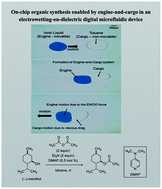On-chip organic synthesis enabled using an engine-and-cargo system in an electrowetting-on-dielectric digital microfluidic device†
Abstract
This paper presents a microfluidic chemical reaction using an electrowetting-on-dielectric (EWOD) digital microfluidic device. Despite a number of chemical/biological applications using EWOD digital microfluidic devices, their applications to organic reactions have been seriously limited because most of the common solvents used in synthetic organic chemistry are not compatible with EWOD devices. To address this unsolved issue, we first introduce a novel technique using an “engine-and-cargo” system that enables the use of non-movable fluids (e.g., organic solvents) on an EWOD device. With esterification as the model reaction, on-chip chemical reactions were successfully demonstrated. Conversion data obtained from on-chip reactions were used to characterize and optimize the reaction with regard to reaction kinetics, solvent screening, and catalyst loading. As the first step toward on-chip combinatorial synthesis, parallel esterification of three different alcohols was demonstrated. Results from this study clearly show that an EWOD digital microfluidic platform is a promising candidate for microscale chemical reactions.



 Please wait while we load your content...
Please wait while we load your content...
